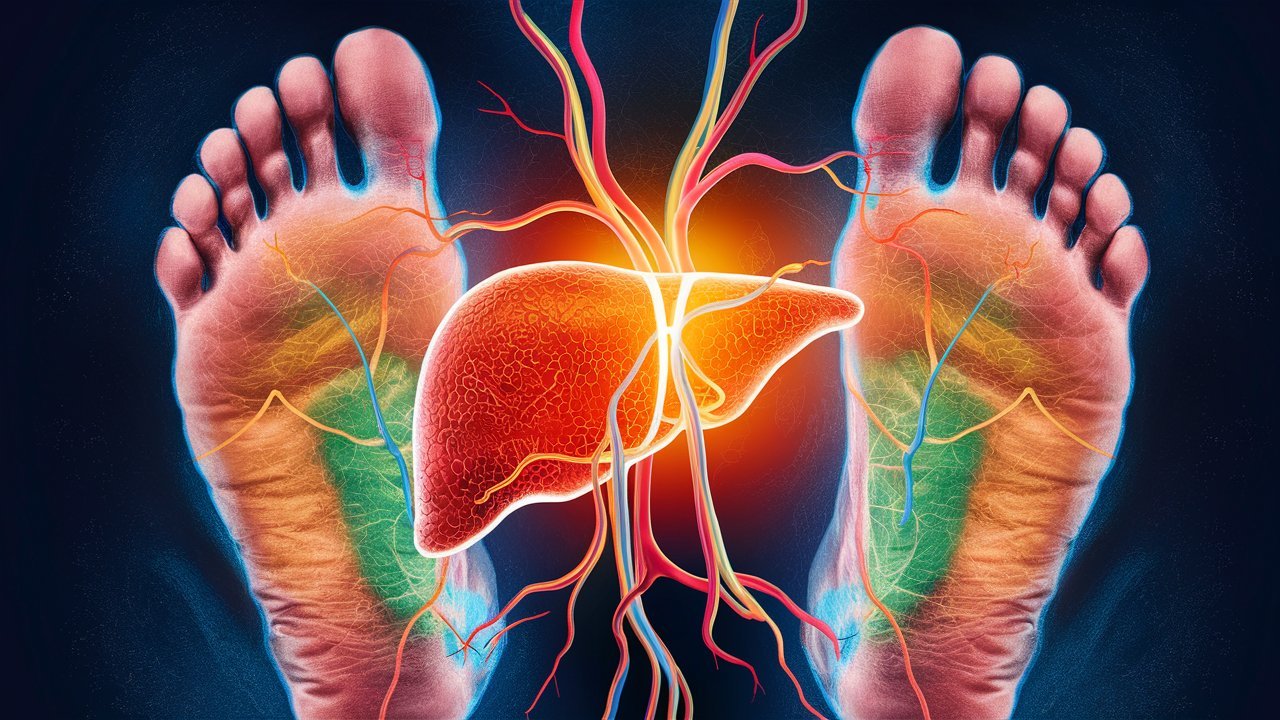Have you ever thought your feet might show signs of liver problems? It’s true, our feet can reveal a lot about our liver’s health.1 In the US, liver disease affects about 4.5 million adults.2 But here’s the thing, liver problems don’t always show symptoms early. This means damage may already be done by the time we notice.1
Your feet might be the early warning system for liver issues. Dr. Berg says certain foot signs might mean your liver is not well.1 These signs include itchy feet, bottom foot pain, hot or smelly feet. Watching for these foot changes could help spot liver problems early on.
Key Takeaways
- Your feet can provide early warning signs of potential liver problems.
- Common foot-related symptoms include itching, pain, inflammation, hot feet, and smelly feet.
- Liver disease affects millions of adults in the United States and is often preventable if caught early.
- Recognizing changes in your feet can help you take proactive steps to address underlying liver health concerns.
- Seeking medical attention when you notice these foot-related symptoms is crucial for early detection and treatment of liver disease.
Introduction to Liver Disease and Its Prevalence
Liver disease is becoming a big problem worldwide. Since 1970, deaths from it have gone up by 400%.3 In England, over 10,000 people died from liver issues in 2020 alone.3 But, if we catch it early, we can usually prevent it.3
Rising Rates of Liver Disease Worldwide
The number of people dying from liver disease has been going up for years.3 This is why understanding this issue is so important. We need to be more aware and take actions to stop it.
Preventable Nature of Liver Disease
Liver disease can often be stopped, especially if found early.3 If we know the signs and act quickly, we can avoid serious liver problems.
Importance of Early Detection
Finding liver problems early is very important. It lets us get treatment before things get worse.3 By watching our liver health closely, we can really help ourselves stay well.
Foot Symptoms as Early Warning Signs of Liver Issues
4 Dr. Eric Berg says our feet might show if our liver is having trouble. Liver diseases and swollen feet go hand in hand, especially if the swelling is in the feet, ankles, or legs. This kind of swelling can point to issues like cirrhosis, hepatitis B or C, liver cancer, or fatty liver disease. These conditions are all linked, which can bring other health problems.
Itchy Feet
4 Itchy feet might signal liver disease, like hepatitis. This kind of itch, called pruritus, is common, showing a connection between our liver and feet.
Pain or Inflammation
4 Joint pain in your feet, similar to arthritis, could mean it’s related to the liver. If you have cirrhosis, are overweight, or have fatty liver disease, this joint pain might be strong. Besides, liver issues can also lead to peripheral neuropathy. This condition damages nerves outside the spine or brain. So, if you feel persistent swelling, burning, numbness, or tingling, it might be time to check your liver.
Hot or Smelly Feet
4 People with liver problems might feel their feet tingle or go numb. This could be due to hepatitis C or liver disease. It’s a hint that there might be a liver health problem.
5 Problems with your liver can lead to foot symptoms. This includes trouble with bile production and circulation. Sadly, liver disease is hard to notice early and can cause big harm before we know it. If we don’t change our ways, 1 in 10 people with liver issues might face serious conditions like cirrhosis, liver cancer, or liver failure. By spotting these early signs in our feet, we can act early. This could help us deal with liver issues sooner and avoid worse problems later.
Toenail and Nail Bed Changes Signaling Liver Problems
Liver issues can change your toenails and nail beds. Your nails might get fungus or become thick and deformed. You could also see white nailbeds, ridges, or nails that look like upside-down spoons.6 Changes in your toenails show how well your body is working. This includes your liver, which helps your body absorb nutrients.7 Watching your toenail health can help find problems early. This means you might catch a liver issue before it’s too late and get better sooner.7
Toenail Fungus (Onychomycosis)
If you have a fungus between your toes, it might mean your immune system is weak. This could be because of liver problems like hepatitis or cirrhosis.6 Checking your toes regularly can pick up on issues, helping you avoid bigger health troubles.7
Dystrophic Nails
Fungal infections can make your toenails thick and odd-colored. You might need antibiotics or even laser treatment in severe cases.7 Diseases like anemia, diabetes, and issues with kidneys or liver often show in your toenails. They may look indented, or the nail beds could be white and reddish.7
White Nailbed (Leukonychia)
Some studies link heart health with changes in your toenails. Signs could be unusual colors, bleeding under the nails, or nails that detach.7 Nail detachment might mean you have a systemic issue, like heart disease.7
Vertical Ridges (Onychorrhexis)
If the soles of your feet often itch, your liver might be in trouble. This could be due to toxins building up. Getting advice from a podiatrist can figure out if it’s a big issue or just a local problem.67
Club Nails
Arthritis or joint pain in your feet could point to liver problems. This shows how closely linked liver health is to the condition of your feet.6 Several diseases can be spotted by changes in your toenails. They might look indented or have odd colors, showing something could be wrong with your liver, kidney, or more.7
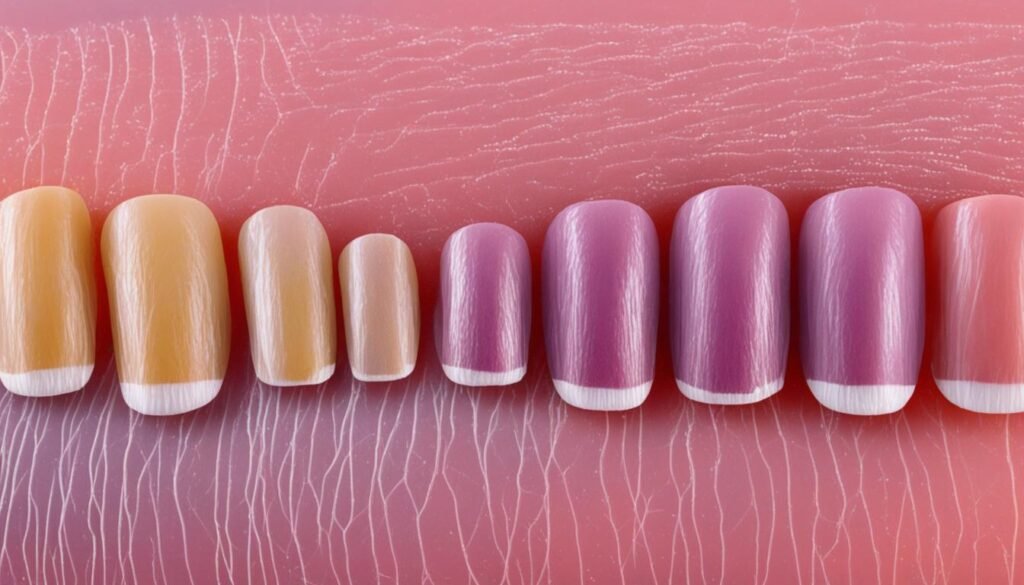
Swelling and Circulation Issues in the Feet
Liver problems can cause swelling and circulation issues in the feet. This may look like pitting edema (dents in the skin), spider veins8, and discolored spots on the feet8. These problems often happen because of hormonal changes. Also, the body might not be able to handle fluids and nutrients well.
Pitting Edema
Pitting edema shows a dent in the skin after pressing it. It can be a sign of liver disease9. The swelling is due to fluid not leaving the body as it should.
Spider Veins
Spider veins are tiny, visible veins on the skin. They can point to liver issues8. These vein changes might be because of hormonal imbalance and poor blood flow from liver problems.
Discolored Spots on Feet
Spots or patches on the feet could be a sign of liver disease8. These changes in the skin are linked to bad blood flow and hormonal shifts from a sick liver.
Looking at swelling, blood flow problems, and color changes in the feet can tell us about our liver health. This information helps us take steps early on to deal with liver problems. Finding and addressing liver disease early is key to staying healthy.
How Your Feet Warns You About Your Liver Problems
Your feet might tell you if your liver is not well.10 The liver and feet are linked. Many things can hurt the liver. These include infections, too much alcohol, and even certain drugs.10 If the liver struggles, it can change how your feet look and feel. Look out for swelling, color changes, and nail problems.
Link Between Liver Function and Foot Health
The liver makes bile to help us digest food better.10 Different liver problems might hurt it in the same way. This can show up as similar foot issues.10 Problems with the liver may first show in feet. This can help spot liver problems early.
Bile Production and Nutrient Absorption
The liver’s job is to make bile for our digestion.10 Sometimes the liver gets hurt fast, but usually, it’s slow. This happens because of many reasons, like taking too much medicine or through some diseases.10 If the liver can’t make enough bile, our body might not get all the nutrients it needs. This can also cause problems with our blood flow, showing up in our feet.
Hormonal Imbalances and Vascular Changes
Bad liver health affects how our body handles fluids and nutrients.10 It might mess with hormone levels too, affecting the feet.10 Watch for early liver problem signs like stomach pain or feeling very tired. Changes in how your veins look or how much your feet swell can also be due to liver issues.
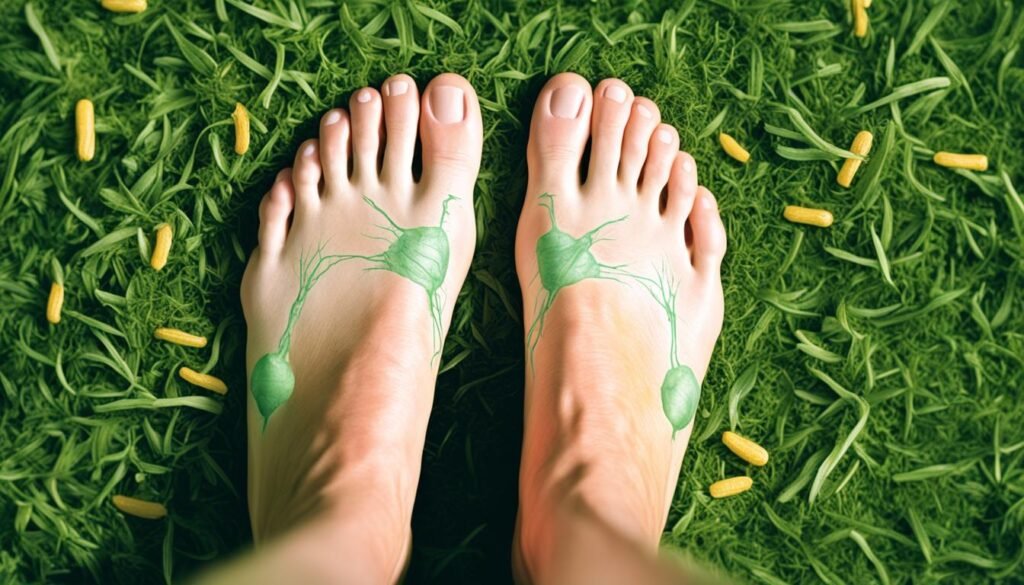
Types of Liver Disease and Their Foot Manifestations
Our feet can tell us a lot about how healthy our liver is. Different liver diseases can cause special foot symptoms. These signs can help us find liver problems early.11 Knowing about the link between liver health and foot issues is important.
Alcohol-Related Fatty Liver Disease
Drinking too much alcohol can cause fatty liver disease. It might show up in our feet first. Watch out for spider veins, odd spots, and dry heels.11 These changes are ways our body shows it’s having trouble getting rid of bad stuff.
Non-Alcoholic Fatty Liver Disease
Sometimes, liver disease happens without heavy drinking. This can cause feet to swell and change color. A sick liver twists how it works with fluids and nutrients, leading to swollen feet and new skin colors.10
Cirrhosis and Its Warning Signs
If liver disease gets worse to cirrhosis, the foot signs get stronger. Feet might swell a lot, turn yellow, or show other bad signs. These mean we need to see a doctor fast.1110 Noticing these foot signals of cirrhosis quickly is vital. It helps avoid more issues and get care on time.
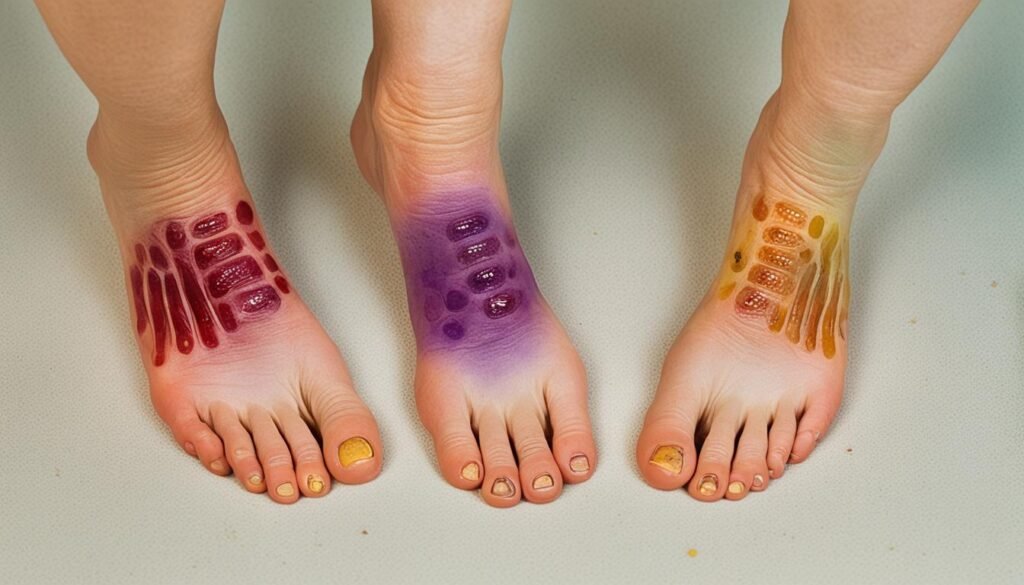
Watching our feet can help us catch liver problems early. This lets us act sooner on our health. Remember, finding issues early can make them easier to treat or even turn around.
Other Symptoms of Liver Disease to Watch For
The feet can warn us about liver problems early. But, there are other signs to see too. Jaundice is a clear sign of liver trouble. It turns the skin and eyes yellow.10 This happens when the liver is not working well and bilirubin builds up.
Feeling pain and bloating in the stomach could mean liver problems too.11 A common spot for this pain is the upper right stomach or below the right ribs. It can feel like throbs or stabs.10 When fluid builds up in the belly, it’s called ascites. This might need draining or medical help.
Being extremely tired, losing your hunger, and seeing poop changes are also signs.11 Feeling tired and weak can signal low oxygen in blood. It could also mean toxins are building up.11 Not feeling hungry, feeling sick, and losing weight are early liver problem signs.10 Poop being pale, pee being dark, and the legs or ankles swelling are more signs of liver disease.
These extra signs, along with changes in the feet, can show liver disease early.11 Spotting liver damage early is crucial. It helps in getting the right treatment and saving healthy liver parts.10 Acting fast by getting medical help and tests can show how bad the damage is. Then, it can guide the best way to stop more damage and help the liver heal.
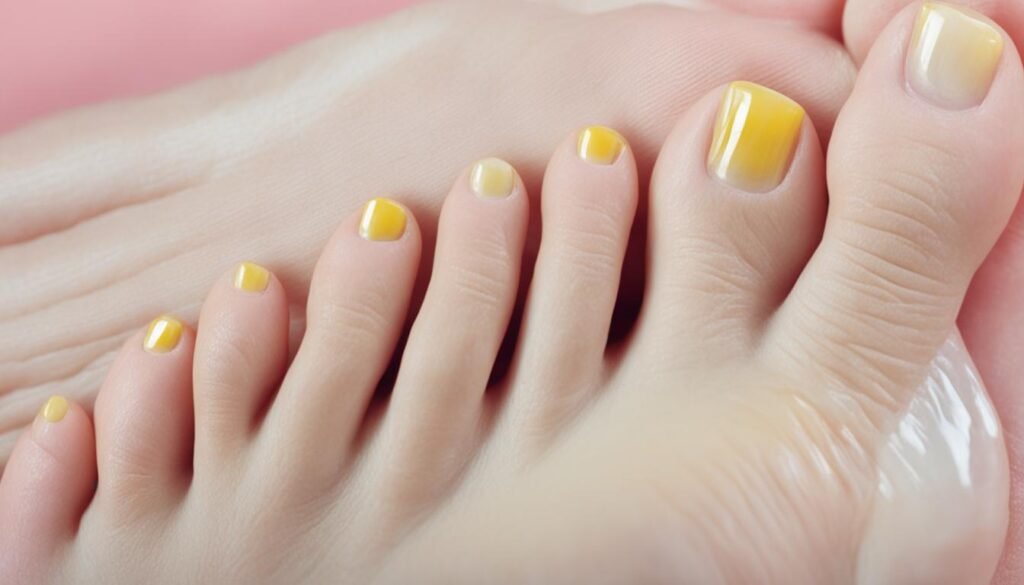
Risk Factors and Prevention Strategies
Risk factors like being too heavy, having diabetes, drinking too much, and getting certain infections like hepatitis make liver disease more likely.12 To keep your liver healthy, eat well, stay active, and if needed, get shots for hepatitis.13 Finding and treating liver issues early is key. Many problems can be controlled or fixed if found soon enough.
Obesity and Diabetes
If you’re overweight or have diabetes, you’re at a bigger risk for liver diseases like NAFLD and NASH.13 Too much fat can turn into cirrhosis if not managed well. So, it’s important to stay at a healthy weight and look after your diabetes.
Excessive Alcohol Consumption
Drinking a lot over time can harm your liver badly.12 A recent study found that any amount of alcohol can raise the cirrhosis risk for women, but for men, it’s after one drink a day.12 Quitting or cutting down on drinking is key to avoid liver issues from alcohol.
Viral Hepatitis Infections
Infections like hepatitis B and C can cause cirrhosis too.12 Hepatitis B affects many in places like Asia and Africa, while hepatitis C is more common among people who do drugs or are on dialysis.12 Getting the hepatitis B vaccine and treating hepatitis C can stop liver disease from happening.
Importance of a Healthy Diet and Exercise
Eating well and staying active are vital for a healthy liver. A good lifestyle can help beat liver conditions and lower the chance of getting cirrhosis.
Vaccination for Hepatitis
For those at more risk of hepatitis, like healthcare workers or those with many partners, getting vaccinated is crucial.12 This shot guards against serious liver illness that hepatitis can cause.
Conclusion
Our feet hint at liver health issues before they become major problems.14 Signs like itchy, swollen, or odd-colored feet give us warnings. We can also notice changes in our toenails. These clues should prompt us to check for possible liver problems. Catching these signs early is key. Many liver diseases respond well to early treatment.
To keep our liver in good shape, we need a healthy way of life. Getting the hepatitis vaccine is a must. Always notice any unusual changes in our feet or overall health. This keeps us on top of things. Also, getting regular check-ups, using supplements carefully, keeping clean, and managing stress are very important for liver care.14
Knowing how our feet and liver are linked helps us spot liver issues early.14 Plus, doing things like eating well, staying active, and taking supplements wisely protects our liver. This way, we can dodge the bad effects of untreated liver diseases.
FAQ
What are the early warning signs of liver problems that can be detected through the feet?
How can changes in the toenails and nail beds indicate underlying liver disease?
How can swelling and circulation issues in the feet be related to liver problems?
What is the connection between the feet and liver health?
What are the different types of liver disease and their corresponding foot manifestations?
What other symptoms, besides foot-related signs, should be watched for when it comes to liver disease?
What are some risk factors for developing liver disease, and what can be done to prevent it?
Source Links
- https://www.huffpost.com/entry/signs-liver-damage_l_665f0fa8e4b022af97ddb2bd
- https://my.clevelandclinic.org/health/diseases/17179-liver-disease
- https://www.niddk.nih.gov/health-information/liver-disease/cirrhosis/symptoms-causes
- https://afaig.com/blog/the-surprising-connection-itchy-feet-and-liver-disease/
- https://www.bswhealth.com/blog/10-early-signs-and-symptoms-of-liver-disease
- https://www.drberg.com/blog/how-to-use-your-feet-to-diagnose-liver-problemsdr-berg-explains
- https://fasafw.com/blog/how-toenail-health-is-an-indicator-of-heart-health/
- https://healthcare.ascension.org/blog/2017/03/your-feet-give-health-warning-signs
- https://www.cvmus.com/vascular-treatment/feet-swelling-treatment-and-causes
- https://www.webmd.com/digestive-disorders/ss/slideshow-symptoms-liver-problems
- https://www.hawaiipacifichealth.org/healthier-hawaii/be-healthy/love-your-liver-look-for-these-8-signs-of-organ-damage/
- https://www.healthline.com/health/cirrhosis
- https://www.mayoclinic.org/diseases-conditions/cirrhosis/symptoms-causes/syc-20351487
- https://medium.com/@groomproinstapro/feet-dont-lie-uncover-liver-secrets-from-your-toes-up-7d22114fc573

